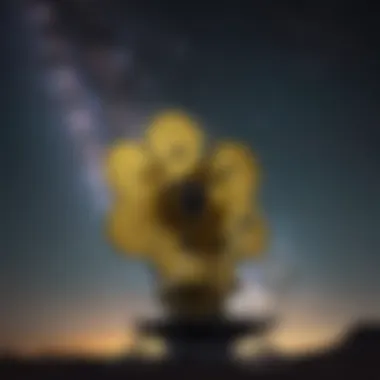The James Webb Telescope: Dimensions and Implications


Intro
The James Webb Space Telescope (JWST) stands as a landmark achievement in astronomical research. It is designed to observe the universe in unprecedented detail, providing insights that were previously unattainable with older telescope designs. Understanding the dimensions of the JWST is essential to grasp how its size and structure contribute to its operational capabilities. This section will serve as the foundation for exploring the implications of these dimensions on our grasp of the cosmos.
In this article, we will explore JWST's key features, the innovative materials used in its construction, and the challenges faced during its development. We will also compare it with other telescopes, examining how its unique aspects will shape future explorations of the universe.
Key Research Findings
Overview of Recent Discoveries
JWST's advanced design has already started to yield significant discoveries. Its primary mirror, measuring 6.5 meters in diameter, allows for greater light collection than its predecessor, Hubble. This means that JWST can identify fainter objects billions of light-years away, uncovering galaxies, exoplanets, and other cosmic phenomena that were previously beyond detection.
Significance of Findings in the Field
The implications of these discoveries are profound. By analyzing light emitted during the early universe, researchers can address key questions related to cosmic evolution and the formation of stars and galaxies. Some specific areas of significance include:
- Studying distant galaxies: JWST enhances our understanding of galaxy formation and evolution.
- Identifying exoplanet atmospheres: It enables the study of chemical compositions in planets orbiting distant stars.
- Examining star formation: The telescope can observe regions of space where stars are in the process of forming, offering insights into stellar evolution.
"JWST is fundamentally designed to give us a view of the universe that we've never had before. Its dimensions and engineering are key to this mission."
Breakdown of Complex Concepts
Simplification of Advanced Theories
As we discuss JWST, understanding its complex mechanics becomes crucial. For instance, the telescope operates in infrared wavelengths, which demands particular technical considerations in its design. This shift allows astronomers to see through cosmic dust, revealing hidden celestial objects.
Visual Aids and Infographics
To visualize JWST’s dimensions and capabilities, one may find various infographics that illustrate comparisons with previous telescopes. These images often highlight aspects like mirror size, light-gathering capacity, and observational range, making complex data more accessible to audiences like students, researchers, and educators.
The advancements brought by JWST not only enhance our comprehension of the universe but reshape the future of astrophysics itself. Its innovative design and capabilities promise to engage the scientific community in discussions that could lead to further breakthroughs in our understanding of the cosmos.
Preface to the James Webb Space Telescope
The James Webb Space Telescope (JWST) marks a turning point in our exploration of the cosmos. It is designed to extend our capabilities far beyond what previous telescopes like Hubble could achieve. Understanding the importance of the JWST is essential as it does not only represent technological prowess but also aims to answer profound questions about our universe.
Overview of JWST's Mission
The mission of the JWST is ambitious. It seeks to examine the universe's first galaxies, explore the atmospheres of distant exoplanets, and investigate the origins of stars and planetary systems. The JWST is equipped with state-of-the-art instruments designed to capture high-resolution images in the infrared spectrum, allowing it to peer through cosmic dust and gas.
- Significant Goals:
- Study the formation of stars and galaxies.
- Examine the chemical composition of distant worlds.
- Investigate the possibilities of life beyond Earth.
The capability of observing phenomena that are otherwise obscured provides an unparalleled opportunity for groundbreaking discoveries in astrobiology, cosmology, and various other fields.
Historical Context and Development


The JWST did not emerge overnight; it is a product of decades of research, development, and collaboration. First proposed in the 1990s, its journey to reality encountered numerous challenges, from budget constraints to technical hurdles. The telescope's design reflects both innovative engineering and scientific foresight.
- Key Timelines:
- 1996: The project is formally initiated.
- 2002: The telescope is named after James E. Webb.
- 2016: The launch date is set for 2021.
This historical background provides context about the dedication required to build such a sophisticated instrument. Its development highlights the collaborative efforts across international agencies, notably NASA and the European Space Agency. The JWST embodies human ambition to understand the universe, and it represents a significant leap forward in our astronomical toolkit.
Physical Dimensions of the JWST
The physical dimensions of the James Webb Space Telescope (JWST) serve as a cornerstone for its overall functionality and capacity to revolutionize observational astrophysics. The significance of its size cannot be overstated. Each component, from the mirror to the sunshield, plays a critical role in how JWST captures and analyzes the cosmos. Understanding these dimensions offers insight into both the engineering marvel that is the JWST and the capabilities it introduces to the scientific community.
Overall Size and Weight
The JWST is notably larger than its predecessor, the Hubble Space Telescope. It boasts a primary mirror that is 6.5 meters in diameter, designed to collect light from incredibly distant objects. This size contributes significantly to its light-gathering ability, allowing JWST to observe faint astronomical phenomena that are beyond the reach of smaller telescopes.
In terms of weight, JWST weighs approximately 6,200 kilograms. This weight is an important detail to consider as it impacts the launch, orbital placement, and eventual operations of the telescope. The high weight necessitates robust components and careful engineering to ensure stability in space.
Mirror Dimensions
The mirror of the JWST is composed of 18 hexagonal segments that form a larger, single surface. Each segment is 1.32 meters in diameter. The design is not merely aesthetic; it serves to create a segmented mirror capable of delivering exceptional resolution. The large size improves the telescope’s ability to collect light without compromising detail. Consequently, this feature enables researchers to explore astronomical phenomena with unprecedented clarity.
The precise alignment and positioning of these segments are critical. Advanced technology is employed to adjust the curvature of each segment post-launch, ensuring that they work in unison to produce a sharp focus. Thus, the mirror dimensions are central to the JWST’s mission of unveiling the universe's mysteries.
Sunshield Size and Function
The sunshield of JWST is equally impressive, measuring approximately the size of a tennis court when fully deployed. This structure serves as a protective barrier, shielding the telescope's instruments from solar radiation and helping to maintain extremely low temperatures necessary for infrared observations. The sunshield consists of five layers of a specially designed material that reflects sunlight effectively.
The functioning of the sunshield is vital to the JWST's opreations. It ensures that the instruments can reach temperatures as low as minus 233 degrees Celsius. This capability is crucial for observinging cooler cosmic events, such as faint stars and distant galaxies, allowing scientists to gather data that would otherwise be impossible to collect.
"The dimensions of the JWST not only define its physical presence in space but also dictate the depth and breadth of its scientific exploration capabilities."
Understanding the importance of these dimensions highlights the complex interplay between engineering and scientific potential. Each aspect, from the overall size and weight to the specifics of the mirror and sunshield, contribute significantly to how the JWST gathers and interprets data from the universe.
Technical Specifications
The technical specifications of the James Webb Space Telescope (JWST) are crucial for understanding how it will advance our knowledge of the universe. These specifications outline the design and functionality of the telescope, which is engineered to observe celestial phenomena that were previously beyond our reach. The importance of detailed technical specifications cannot be understated, as they inform researchers and engineers about the telescope's capabilities, limitations, and potential applications in various fields of astrophysics.
Optical System Design
The optical system design of the JWST is one of its most sophisticated aspects. At the heart of this design is its large primary mirror, which measures 6.5 meters in diameter. This mirror is segmented into 18 hexagonal pieces made of beryllium and coated with a thin layer of gold to optimize reflectivity in the infrared spectrum. The configuration allows the telescope to gather more light than smaller telescopes and facilitate observations of faint astronomical objects.
The optical design also includes intricate mechanisms for alignment and positioning of the mirror segments. These elements are vital for ensuring that the light collected is focused correctly onto the instruments that analyze the data. Moreover, the telescope uses specialized lenses and filters that enable a range of observations across various wavelengths, from near-infrared to mid-infrared.
Instruments and Their Capacity
This section highlights the instruments aboard the JWST, each tailored for specific scientific objectives. The capability of these instruments significantly enhances the observational power of the telescope.


- Near Infrared Camera (NIRCam): This instrument is designed to study the formation of stars and galaxies. It has the capacity to detect light from the earliest stars, thereby giving insights into the universe's infancy.
- Near Infrared Spectrograph (NIRSpec): NIRSpec has the ability to operate in spectroscopy, allowing it to analyze the composition of distant celestial bodies. The instrument can observe multiple targets simultaneously, enhancing its efficiency.
- Mid-Infrared Instrument (MIRI): MIRI is crucial for detecting thermal emissions from celestial objects. This allows astronomers to study cooler and fainter objects, such as comets and newly forming planetary systems.
- Fine Guidance Sensor/Near InfraRed Imager and Slitless Spectrograph (FGS/NIRISS): This instrument is essential for precise positioning of the telescope. It helps in ensuring that JWST stays accurately aimed at its targets.
The cooperation between these instruments maximizes the scientific return from the observations. The specifications ensure that JWST can provide a comprehensive view of astronomical phenomena, addressing both theoretical and observational questions in modern astrophysics. This detailed approach marks a pivotal leap in our ability to explore deep space, leading to groundbreaking discoveries in the future.
Comparative Analysis with Previous Telescopes
The comparative analysis of the James Webb Space Telescope (JWST) with past telescopes is an essential aspect of understanding its advancements and capabilities. This section highlights specific elements that make JWST a monumental step forward in astrophysical research. By examining the technological differences, observational capacities, and structural designs, one gains a clearer picture of its significance relative to predecessors like the Hubble Space Telescope and other ground-based observatories.
Comparison with Hubble
The Hubble Space Telescope has been a cornerstone of astronomical imaging since its launch in 1990. Its observations have reshaped our understanding of various cosmic phenomena. However, JWST brings a new level of sophistication to space observation.
- Wavelength Range: While Hubble primarily captures ultraviolet and visible light, JWST is optimized for infrared observation. This allows it to peer through dust clouds and observe cooler celestial bodies that Hubble cannot. This enhancement opens up new avenues in studying planetary formation and the early universe.
- Mirror Size: Hubble's primary mirror has a diameter of 2.4 meters, which limits its light-gathering power. In contrast, JWST features a primary mirror that spans 6.5 meters, significantly increasing its light-gathering capacity. This increase allows JWST to observe fainter and more distant objects than its predecessor.
- Orbital Position: Hubble operates in low Earth orbit, exposing it to atmospheric interference. JWST, however, orbits at the second Lagrange point, L2, around 1.5 million kilometers from Earth. This location minimizes interference from Earth’s atmosphere and light pollution, enabling clearer data collection.
Comparison with Other Ground-Based Observatories
Ground-based observatories like the Keck Observatory and the Very Large Telescope (VLT) have advanced technologies for astronomical observation. However, they face limitations that JWST overcomes:
- Atmospheric Distortion: Ground-based telescopes are affected by the Earth's atmosphere, which can distort images and reduce clarity. JWST's location in space eliminates this issue completely, leading to sharper and more reliable images.
- Infrared Observations: JWST is designed specifically for infrared astronomy, which is crucial for studying cool objects such as brown dwarfs and distant galaxies. Ground-based telescopes have infrared capabilities, but atmospheric interference can seriously hinder observations.
- Size and Design: Many ground-based telescopes, while large, often cannot rival the design sophistication of JWST’s segmented mirror system. This innovative approach not only enhances performance but also allows for a larger collecting area, further boosting observational capabilities.
JWST's advanced engineering and positioning in space symbolize a significant leap in our observational technology compared to previous telescopes.
By articulating these comparisons, it becomes apparent that JWST does not just serve as an improvement over past telescopes; it completely redefines the landscape of astrophysical observation. Its unique capabilities will profoundly impact our quest to understand the universe anew.
Engineering Challenges
Understanding the engineering challenges behind the James Webb Space Telescope (JWST) is crucial to appreciating its development. These challenges encompass a range of technical, logistical, and environmental considerations that underline the telescope's ambitious goals. The complexity of JWST's design necessitated innovative solutions, ensuring that it could function optimally in the harsh conditions of space.
Design and Construction Issues
The design of the JWST posed numerous challenges from the outset. It features a large segmented mirror, which spans 6.5 meters in diameter, made up of 18 hexagonal segments. This design was critical for maximizing light-gathering capabilities but required precise alignment and calibration once assembled. The intricate foldable structure needed to be transported to space compactly; thus, engineers had to meticulously plan how each component would fit together in orbit.
Moreover, the materials chosen for JWST's construction had to withstand extreme temperatures and radiation found in space. For instance, the sunshield consists of five layers of a special type of film called Kapton, which helps to protect the instruments from solar heat. This decision required exhaustive testing, ensuring that the materials would perform reliably over the mission's anticipated lifespan of 10 years or more.
Testing and Deployment Processes
Once constructed, the testing phase of JWST was paramount. Engineers utilized vacuum chambers and thermal tests to simulate the environment of space. JWST underwent rigorous examinations to ensure its systems would operate correctly after launch. This included checking optical performance and verifying that the sunshield could deploy properly once in orbit.
Deployment processes were particularly challenging. Upon reaching its designated location at the second Lagrange point (L2), several critical events needed to occur flawlessly. These included the unfolding of its sunshield and the deployment of its mirror segments. Each of these processes was carefully choreographed, with contingency plans in place to address potential issues.
In summary, engineering challenges faced during the development of the JWST were numerous and complex. The successful navigation of these challenges has not only added to our capacity for astronomical observation but has also provided valuable lessons for future projects in space exploration.
Implications of Size on Observational Capacity
The size of the James Webb Space Telescope (JWST) plays a crucial role in its observational capabilities. Larger size not only aids in gathering more light but also enhances the functionality of its instruments. This section will explore the significance of size, which impacts multiple facets of astronomical observation. Understanding these implications opens a comprehensive view of how the JWST is set to redefine our exploration of the cosmos.
Light Gathering Power


The JWST's substantial size allows it to gather more light than many previous telescopes. The primary mirror, which is 6.5 meters in diameter, is significantly larger than Hubble's 2.4-meter mirror. This difference translates to the ability to collect more photons, resulting in stunning images of distant celestial bodies. More light can also lead to better signal-to-noise ratios, which is vital for detecting faint objects in the universe.
A telescope's light gathering power can be quantified using the formula that depends on the area of the mirror. The area of JWST's primary mirror is about 25 square meters compared to Hubble's 4.5 square meters. This results in a light collection capacity that is approximately 6.25 times greater than Hubble's. This enhanced light gathering is essential to observe dim objects, enabling astronomers to explore phenomena like the formation of stars and galaxies that existed billions of years ago.
In practical terms, this means that JWST is capable of producing images and spectra that would be impossible to capture with smaller telescopes. The improved light sensitivity enhances the potential for groundbreaking discoveries in astrophysics.
Field of View and Resolution
Another important aspect of the JWST’s dimensions is its field of view and resolution. A larger mirror not only enhances light collection but also improves the telescope's ability to resolve finer details. Resolution refers to the telescope’s ability to distinguish between two closely spaced objects. The JWST's advanced optics and design deliver a resolution strong enough to observe distant planets and stars with clarity.
- Field of View: The field of view in telescope terms refers to the extent of the observable world seen at any one time. JWST's size allows for a relatively larger field of view, which captures more area of the universe in a single observation. This is exceedingly valuable for surveys and large-scale mapping of celestial features.
- Resolution: Resolution is linked to the telescope's ability to separate two objects that are close together in space. With its innovative design, JWST minimizes the effects of atmospheric distortion, enabling high-resolution imaging. A good example is observing exoplanets, where clarity of detail is essential for identifying atmospheric compositions or signs of habitability.
"JWST's dimensions directly correlate with its unprecedented ability to collect data, pushing the boundaries of what we can investigate in the universe."
Future Research and Discoveries
The James Webb Space Telescope opens new doors for research within the field of astrophysics. Its advanced capabilities will allow scientists to probe deeper into the universe. Understanding those possibilities aids in grasping the importance of JWST's dimensions and its implications for humanity's journey in understanding celestial phenomena.
Potential Discoveries in Astrophysics
The JWST is expected to yield major breakthroughs in astrological observations. One significant area is the study of the early universe. The telescope's powerful infrared capabilities allow it to look back in time. It can observe the formation of the first stars and galaxies that existed thousands of millions of years ago. Such discoveries promise to answer questions about cosmic evolution and matter formation.
Another vital area is the exploration of galactic formations. With its large mirror and high-resolution instruments, JWST can analyze the composition and behavior of celestial bodies within various galaxies. This means it can reveal the interactions between dark matter and regular matter, providing essential insights into cosmic structure.
The data from JWST could also lead to new theories in theories of gravity or cosmology, reshaping our understanding of fundamental physics. As researchers analyze the information this telescope provides, unexpected phenomena will likely challenge current paradigms, sparking new inquiries and theories.
Impact on Cosmology and Exoplanet Studies
Beyond astrosociology, JWST has a profound impact on cosmology and exoplanet studies. Its capacity to explore atmospheres of exoplanets puts it in a unique position. By characterizing these atmospheres, JWST can help identify chemicals that hint at biological processes. This would be a step closer to understanding if there are conditions suitable for life beyond Earth.
The telescope can also examine star formation within our galaxy and others. Understanding how stars form and evolve is fundamental to knowing galactic life cycles. Analyzing these processes in various environments leads to deeper comprehension of the universe.
Moreover, the existence of gravitational waves can be further examined through JWST's observations of cosmic events. Understanding gravitational lensing offers insight into how massive objects bend light and how matter distributes itself.
"The implications of the James Webb Space Telescope are vast, potentially altering our understanding of the universe and our place within it."
In summary, the potential discoveries facilitated by the James Webb Space Telescope extend far beyond initial expectations. As it surveys the universe, the relation between size and observational capacities of JWST plays a crucial role in expanding our horizons not just in astrophysics, but also in cosmology and beyond. The future holds numerous possibilities, and the research opportunities offered by JWST will shape our understanding of the cosmos for years to come.
Finale
The conclusion of this article serves to underline the monumental significance of the James Webb Space Telescope (JWST) within the scope of modern astrophysics. By revisiting key elements discussed throughout the piece, we establish a clear understanding of how JWST's innovative design and impressive dimensions bring forth transformative benefits to the field of astronomy.
Recap of JWST's Significance
The JWST is unlike any previous telescope built, both in its physical dimensions and its operational capabilities. Its mirror, measuring 6.5 meters in diameter, allows it to collect vastly more light than any other space telescope. This feature is paramount for observing faint and distant celestial objects. Moreover, the design of the sunshield, which spans the area of a tennis court, ensures that the telescope operates at optimal temperatures, enabling high-quality infrared observations.
Furthermore, the technological advancements inherent in JWST's instruments facilitate the investigation of a wide array of cosmic phenomena, ranging from the formation of stars to the atmospheric composition of exoplanets. By enhancing our ability to capture unprecedented data, the JWST is poised to enrich our understanding of the universe in ways that previous telescopes could not accomplish.
Final Thoughts on Future Potential
As the JWST commences its mission, the implications for future research appear vast. Its grand ambitions include investigating the origins of galaxies, exploring the birth of stars and planetary systems, and enriching our knowledge of exoplanets—especially those situated within habitable zones.
Looking ahead, the data generated by this telescope may lead to paradigm-shifting discoveries that could redefine our understanding of astrophysics and our place within the cosmos. With its tools and capabilities, JWST stands as a beacon of future potential, poised to address questions that have eluded humanity for centuries. The future of astronomical exploration is bright, and the JWST is at the forefront of this journey.















